Who is Lord Muruga?
Lord Muruga, the younger brother of Lord Ganesha, is the protector of our earth plane. As the protector, he is ever concerned about the welfare of human beings and the planet earth. Muruga is also the Lord of the Pleiades (A star cluster in the constellation Taurus). Lord Muruga is associated with the birth star Krithika; a very precious birth star. He represents the primordial energy and force.
Lord Muruga is more popular in South India compared to other parts of India. He is the God of war and the patron deity of the Tamil land (Tamil Nadu); and is known by many other names, including Senthil, Saravana, Karttikeya (meaning 'son of Krittika'), Arumugam or Sanmuga (meaning 'one with six faces'), Kumara (meaning 'child or son'), Guha, Skanda, Subrahmanya, Velan and Swaminathan.
Lord Muruga is known to guide human beings to a higher life. Basically a celestial warrior, he constantly battles and destroys demons that prevent good things (the grace of light) from entering the earth plane.
Kartikeya is symbolized with the weapons he wields on the battlefield - Vel, the Divine Spear or Lance that he carries and his mount, the peacock. He is depicted with many weapons including a sword, a javelin, a mace, a discus and a bow or wielding a spear. This symbolizes his purification of human ills. His javelin symbolizes protection, discus symbolizes knowledge of the truth, mace represents strength and bow shows ability to defeat all ills. His peacock mount symbolizes the destruction of the ego.
His six heads represent the six siddhis bestowed upon yogis over the course of their spiritual development.
The Legend and his "6 Battle Houses":
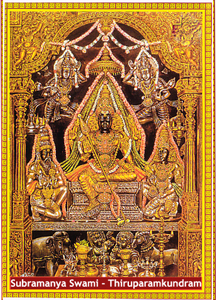
As Lord Muruga emerged as six sparks of flame from the third-eye of Lord Shiva, he always defeats the evil forces to save his devotees and disciples. The popular south Indian maxim goes, "Wherever there is a mount, there is a shrine for Lord Muruga; the omnipresent!"
Lord Muruga has six famous abodes in Tamil Nadu which are collectively known as 'Arupadai Veedu'. In Tamil 'Aru' means six and 'Veedu' means home. Every abode of Lord Muruga commemorating an event mentioned in the puranas(old stories). Thiruparankundram, Thiruchendur, Palani, Swamimalai, Thiruthani and Palamuthircholai are His six abodes.
Thiruparankundram (5 kms from Madurai)
This is the first abode of Lord Muruga lying on the outskirts of Madurai in Tamil Nadu. God here is worshipped as Lord Subramanya Swami and this is the place where he wedded Shri Deivanai, daughter of Deivendiran, the leader of Devas, in the presence of Sun and Moon. As per legends, it is told that after having won the demons, the Lord was honored and celebrated by offering Deivanai as his consort. This was to thank the Lord from saving from cruel bondage with the demons.
The temple is situated at the foot of 700 foot high rock and it has separate shrines for Lord Ganapathy, Lord Shiva, Devi Durga and Lord Vishnu. The entrance of temple has 48 Nayakkar period pillars with engraved artistic cravings. The speciality of Thiruparankundram is that the innermost shrine has been carved from a single rock. Thiruparankundram is also renowned as an auspicious place for conducting marriages.
In this temple, there is 'Saravana Poigai' a holy water tank from where water will be brought by the elephant for 'Abhisekam'.
Thiruchendur (100km south of Madurai):
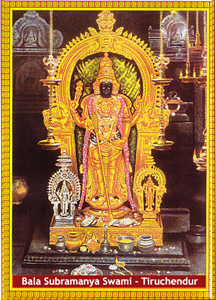
Tiruchendur is the second abode of Lord Muruga. Here he is worshipped as Lord Bala Subramanya Swami, Lord Senthil Nathan and Lord Senthil Kumar. This is a unique abode of Lord Muruga situated on the seashore; whereas other abodes are on the top of hills.
It is believed that the temple was built by Desigamoorthy Swamigal belonging Thiruvaduthurai Adeenam about 300 years ago. The main tower is 137 foot high and is 90 ft by 65 ft at base. It has 9 levels to indicate 9 kalasams which are placed on the top of the tower. There are two corridors in the temple where we can see various deities. After circumambulating two corridors, one reaches the Mahamandapam (the inner area lying in front of the sanctum) for a darshan of the main deity Lord Bala Subramanya Swami.
This shrine is famous for the festival 'Kantha Sashti' which is cordially celebrated every year. On that day, thousands of devotees assemble on the sea shore to see the climax of the festival where Lord Muruga kills the demons Surapadma and his brothers.
Palani (120 kms west of Madurai)
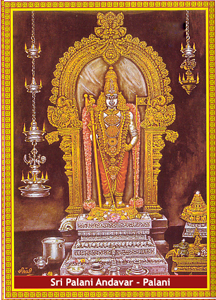
This is the third abode of Lord Muruga where he stands on the top of 150 m high rock. Here he is known as Sri Palani Andavar, the lord with the staff in his hand. The deity at the sanctum is made out of an amalgam of nine important minerals called as 'Nava Bashana'. The deity here is also called as Lord Palani Appan and Lord Andiappan.
There is a legend as to how Lord Muruga came to this sacred shrine. Shri Narada Muni, a sage, once brought a golden mango to the home of Lord Shiva seated with his consort and children Lord Vinayaka and Lord Muruga. Narada Muni gave the fruit to Lord Shiva and prayed him to eat it since it was rare and fruit of Gnana (fruit of wisdom). The divine couple wanted to give it to their children. But the conditiom was that it should be eaten wholly for its total benefits. Lord Shiva announced a contest, wherein whoever completed one round of the globe first would get Gnana Fruit.
Lord Muruga immediately mounted on his vehicle peacock to go around the world. But, Lord Vinayaka's mouse was no match for the peacock in its speed. Lord Vinayaka circumambulated his parents, symbolizing the world and got the fruit. On return, Lord Muruga found that he was cheated. In anger, he renounced his family and came to Palani to settle. Lord Shiva and Devi Parvathi came to pacify him, and named the vortex as Palani.
'Thaipoosam' is cordially celebrated every year here. The temple is very spacious with beautiful mandapams and carved pillars. Golden Chariot is the speciality of this shrine. The great Tamil poetess and saint Avvaiyar had been tested for her knowledge by Lord Muruga. Here is where Lord Kanda blessed the old Tamil Poetess with bountiful knowledge.
Swamimalai (5 km away from Kumbakonam):
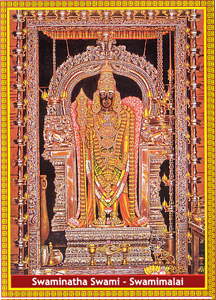
It is the fourth abode of Lord Muruga. Here our Lord gets the name 'Swami Nathan' as he expounded the meaning of Pranava mantra 'Om' to His father Lord Shiva. The temple is about 5 km away from Kumbakonam in Tamil Nadu, on the bank of River Cauveri. Legend has it that saint Bhrugu before commencing an arduous tavam or penance; got the boon anybody disturbing his meditation will forget all his knowledge. Such was the power of the penance the sacred fire emanating from the head of the saint reached up to the heavens and the frightened Devas surrendered to Lord Shiva praying for His grace. The Lord extinguished the sacred fire by covering the saint's head by hand. With saint's penance thus disturbed the Lord became oblivious of all His knowledge and is said to have regained them by learning Pranava mantra from Lord Muruga at this shrine.
Once when Brahma, the Lord of all creations was proceeding to Kailash, the child Lord Muruga asked Him for the meaning of Pranava mantra, 'Om'. When Brahma admitted His ignorance, the Lord imprisoned Him. With Brahma imprisoned, all creations came to a standstill and the Devas prayed to Lord Shiva to get Brahma released. Lord Muruga expounded the meaning of 'Om' and only after Shiva accepted Muruga as a Guru and listened to the exposition as a devoted disciple. The temple is built on an artificial hillock of about 60 foot height with beautiful laid stone steps representing the Hindu cycle of sixty Tamil years leading to the Lord. In the ground floor there are temples dedicated to Lord Sundareswarar and Goddess Meenakshi. Every year Chitra Pournami is celebrated in this shrine.
Tiruthani (50 Km north of Chennai):
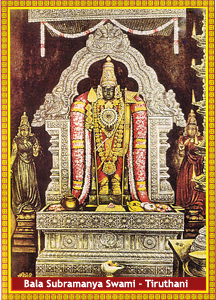
According to Puranas, Lord Muruga married Shri Valli in this shrine, and he is called Bala Subramanya Swami. The shrine is situated at about 50 km north of Chennai, Tamil Nadu, at a 250 m high mountain. Thiruthani is famous for Adi Krithikai festival between the months of July and August. On this festival thousands of devotees offer flower kavadi to Lord Muruga. Kantha Sashti is another festival celebrated here in the months of October and November.
It was only upon worshipping Lord Muruga at Thiruthani, the king of snakes Vasuki got his wounds healed which was caused during the churnning process in the Milky Ocean to get Amrita held by Devas and Demons. It was here Lord Brahma propitiated the Lord Muruga at a holy spring known as Brahma sonai after his imprisonment by our Lord for his failure to explain the Pranava mantra 'OM'
Saint Arunagirinathar has praised this hill as the chosen place for worship by the great devas and the favorite abode of saints to perform prolonged tapas (meditating on God for years together at a stretch). Sri Muttuswami Deekshitar, who lived 200 years ago (one of the trinity of the "Carnatic music'- the Traditional music of south India) had his inspiration in Tiruthani when the Lord Muruga (in the disguise of an old man) met him on the steps of the temple and sweetened his tongue with the prasad of this temple. This had provoked him to sing his first song on Lord Muruga of Tanikai
Pazhamudircholai (10 miles north of Madurai):
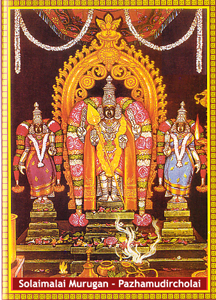
This is the sixth abode of Lord Muruga which lies about 19 km away from Madurai, Tamil Nadu. Lord Muruga stands on the top of the hill which can be reached by the motarable road, and he is called "Solaimalai Murugan" here. This very beautiful shrine is surrounded by green woods, shrubs and hills. At the foot of hills is the, "Alagar Kovil" temple which is one of the important temples of Lord Vishnu.
Pazhamudircholai is the abode where Lord Muruga stands with both his consorts Shri Valli and Shri Deivanai. Though the temple is the simplest of all, it is the most beautiful one amidst natural sceneries.
Pazhamudircholai is a hill rich in fruits, vegetables and flowers. It is a dense forest where "Valli" is supposed to have lived. There is a temple tower and monkeys abound around the area. It is a fertile hill with many natural springs and herbs.
No comments:
Post a Comment